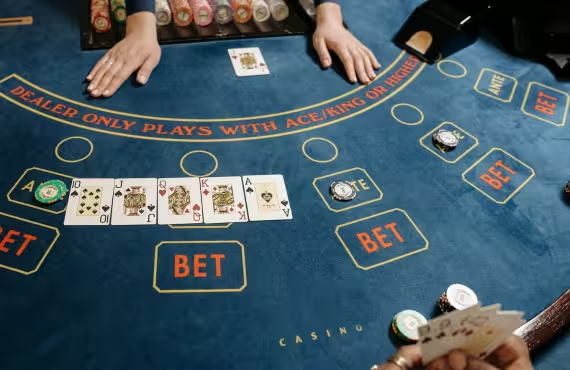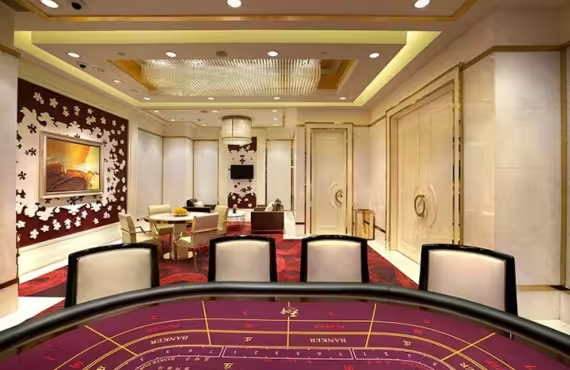Inside the World of High-Stakes Baccarat: How the Elite Gamble

Baccarat. High-stakes baccarat (said like Bond. James Bond). It’s 007’s game of choice, and there’s a reason why.
Just like MI6, the casino game has the reputation of being mysterious and out of reach for normie gamblers. It’s a game of luxury played in VIP rooms in Monte Carlo and Macau; everyone is dressed to the nines, and the players are all high rollers.
You’ve seen it in Casino Royale: Daniel Craig sitting at the table in a Tom Ford Gucci tux across from wealthy players throwing around huge sums of money. It’s glam, exclusive, and surrounded by mystique.
But behind the exclusive-looking exterior, the game has surprisingly simple rules and friendly odds for players! Although the majority of casual gamblers will play mini-baccarat for a few dollars, there is a hidden world where the stakes are astronomically high; single hands of baccarat can run into the hundreds of thousands or millions of dollars.
We want to explore this high-stakes baccarat world! We’ll explain what baccarat is, who plays it, why it so enthralls the super-rich, and how casinos roll out the red carpet to keep these VIPs betting.
The Allure of Baccarat
The first order of biz is to explain baccarat! It’s actually super easy to learn. In each round, two hands are dealt (the “Player” and the “Banker”), and punters bet on which hand will end up closest to 9.

If the banker’s hand wins, the player loses, and vice versa (ties pay out at long odds). Officially, the banker bet wins 45.8% of the time and the player 44.6%. Because casinos charge only a 5% commission on winning banker bets, the house edge is super low; about 1.06% on the banker and 1.24% on the player bet. As for ties, they are extremely rare and heavily in favor of the house. All of this means that baccarat has some of the best odds in the casino, and it’s why so many elites gravitate to it.
‘The King’ of Casino Games
Baccarat is referred to as “the king” of casino games due to the sheen of exclusivity that surrounds it, but also for its straightforward mechanics in contrast to games like poker that call for strategy.
Anyone can feel comfortable making a $100,000 bet without worrying about complicated rules of play. And with the easy rules, it is that remarkably low house edge we talked about. A banker bet in baccarat has almost exactly a 1.06% casino advantage, meaning on average that a $100 bet loses about $1.06.
That’s better than most games except for blackjack! Even the popular tie bet, which is a long shot with around a 9.5% chance, has a 14.36% edge, so smart high rollers usually avoid it.
Baccarat’s appeal is due in part to the math; its basic probability dressed up in a tuxedo. The net effect is a game that feels much fairer to the player while it still pays out to the house over time.
In Macau, which is the world’s highest-stakes gambling mecca, baccarat holds court over everything. It was reported that in 2024, Macau’s casinos derived over 88% of their $33.2 billion revenue from baccarat alone, and other table games barely register by comparison.
In Vegas as well, baccarat tables punch well above their weight: Nevada’s casinos won $1.37 billion from baccarat in one year, which is far more per table than blackjack (on fewer tables overall). Part of baccarat’s strength is just scale: players can bet far more per hand, driving massive turnover and revenue. Roger Snow of Global Gaming Business Magazine said that it’s common in Macau and Singapore to see $100,000 bets per hand, with some tables allowing wagers up to half a million or more. This means that one lucky streak at a baccarat table can make millions, and that’s something no other game can compete with.
But numerical odds are only a part of baccarat’s mystique. Tradition and prestige also play a role; the game’s heritage as a pastime of nobility and high society still lingers; today, baccarat tables bring in clientele who enjoy status just as much as they do money. And because baccarat was portrayed several times as being Bond’s game of choice, it carries a cinematic cachet.
Who Plays High-Stakes Baccarat?
The demographics at a high-roller baccarat table read like a Who’s Who of wealth and notoriety; billionaires and big-wealth tycoons are commonly drawn to these games. Let’s take a look at who is playing this game!
The most notable ones include people like the Australian media mogul Kerry Packer, who famously gambled millions per trip to Las Vegas and usually wrote $1 million checks to the pit boss.
Global casino executives will tell you they “all knew better than to keep him waiting” when Packer wanted to lay a bet. His kind of casual fortune meant stakes that would break smaller players became routine; after a series of nights, Packer famously left the Bellagio in the hole to the tune of ~$33 million, although he’d won more on other nights. He epitomized the “whale” gambler, a casino’s most prized customer whose rolls of the dice can make or break a day’s take.
There are tons of lesser-known high-net-worth people, usually from the finance, tech, or real estate world, who get access to these games via private junkets or credit arrangements.
Hollywood also produces celebrity gamblers from time to time. Singer Gladys Knight wrote of her decade-long obsession with baccarat that nearly bankrupted her. In general, though, it’s the truly wealthy and not celebrities who frequent these stakes, as Macau’s VIP halls are largely filled by Asian high-rollers.
Culturally, baccarat is hugely popular in many parts of Asia, especially among the Mainland Chinese and the Hong Kong elite. Casinos there cater heavily to Chinese punters with all-Chinese-speaking pits and customary “fortune” rituals. A casino director said that in those markets, “baccarat is perceived as easy to learn and fair,” and it offers a communal excitement: players will watch scoreboard trends and physically squeeze cards together. Most Asian gamblers treat baccarat almost like a social sport of chance, where large groups will gather and follow the same winning streaks.
What about Western players? In the US, “whales” usually come from industries like finance or inherited wealth. A famous case is Terrance Watanabe, a Nebraska millionaire who gambled $825 million over a year in Las Vegas and lost $127 million, and it was mostly at baccarat. He ended up nearly bankrupt and facing lawsuits for unpaid debts. But casinos don’t shy away from these players, because even losers like Watanabe can generate very lucrative volume; he gave Caesars and Harrah’s a 5.6% revenue bump just from his losses in 2007.
Other big-name gamblers (e.g., the late Japanese tycoon Akio Kashiwagi) became legendary in baccarat circles for their wins and losses. And yes, a few celebrities who gamble big (like movie producer Ben Affleck or athlete Michael Jordan) have been known to partake in baccarat at the highest levels, although it’s usually under the cover of a casino host.
Perhaps most importantly, the draw for all of these players is not only the money but the whole experience of it.
High-stakes baccarat tables have an exclusive atmosphere and a jolt of adrenaline that’s hard to replicate. Your typical billionaire or “whale” is already used to limits, so what drives them is pushing beyond the known limits. The fact that baccarat tables allow players to bet $250,000 to $300,000 on a single hand (like in private blackjack games) means that the game becomes about chasing that rush. Being in a gilded salon surrounded by a personal host, chewing on a high-end cigar as the cards flip, is all part of the allure. For these gamblers, baccarat gives them both a social status (only the richest sit there) and a raw thrill: every hand could multiply or wipe away fortunes. High-rollers are literally given the keys to the city, and baccarat is the lock they put the key in.
The VIP Casino Experience
When a whale walks in, casinos immediately start the VIP treatment. In major resorts from Macau to Las Vegas, there are entire private baccarat salons, which are separate rooms that feel more like luxury lounges than gambling halls.
The rooms might have only a few tables (or just one), and are decked out with plush sofas, flat-screen TVs, and 24/7 cocktail service. At MGM’s The Mansion in Las Vegas, RJ Cipriani, a pro gambler, stayed in a penthouse with its own baccarat table behind a locked door. He recalled bringing only a dealer and a pit boss into that secluded game, so the stakes could go as high as he wanted. Many casinos similarly maintain “salons” where the only patrons are VIPs who post seven-figure deposits.
Private Rooms
The exclusive areas mean even the biggest gamblers get privacy, and they’re usually staffed by a pit boss and a camera, but no onlookers. As Cipriani said, he only plays blackjack (similar stakes as baccarat) “in private rooms, where there is no one inside but him, a dealer and a supervisor.” In Macau and Singapore, these rooms are so prized that players have to negotiate buy-ins of hundreds of thousands just to set foot in the door.
Lavish Perks
The fringe benefits in these VIP rooms are legit off the charts. Casinos will comp first-class travel (yes, private jets) to get a high roller in the door. Once you arrive, you can expect things like complimentary luxury suite accommodations (usually $10,000+ per night rooms) with panoramic city views, caviar and Michelin-starred dining on the house, and personal butlers or concierges that are dedicated to you.

Cipriani said that everything can be free, “from drinks to spa treatments to designer clothes” for whales. Top-tier gamblers will throw lavish parties using the casino’s resources and jet in dozens of friends, booking out the best restaurants, or renting penthouses, and it’s all comped by the casino because of a gambler’s high guaranteed play. Casinos invest huge resources and money to make the whales feel like they’re royalty.
Personal Casino Hosts
There’s usually a casino host assigned to each VIP, and they cultivate personal relationships: greeting the player on arrival, arranging entertainment (concert tickets, golf outings, etc.), and even helping with things like dinners or shopping trips. They’re the liaison who makes sure that the gambler keeps coming back.
A host can reserve a VIP Baccarat table with no minimums, or slip an extra $50,000 in free play just for fun. All comps (free stuff) are calculated by “deal point memos,” which are detailed contracts spelling out what the casino will provide. In RJ Cipriani’s words, this memo is “the high-roller’s equivalent of a musician’s rider,” and it includes everything from gourmet meals to top-shelf liquor; all negotiated between the player and casino.
Building Loyalty
The goal is to make a high-stakes gambler stay loyal. Casino executives say that once a VIP has generated substantial revenue, it pays to reinvest some of it back into the player. That means if you lose $500,000, the casino could “refund” 20% of that loss by comping back $100,000 in chips.
Players like Cipriani say they will not stay loyal unless the “incredible deals” keep on coming, so every aspect of the VIP experience, from the lush environment to the perks to the attentive service, is designed to keep whales engaged and betting. Because the more they play? The more the casino usually wins in the long run.
How High the Bets Go
Just how extreme do the wagers get at these elite tables? One word: extremely. It’s not uncommon for hands of baccarat to involve six- or seven-figure stakes. Below is a sobering list of record hands and sessions that were famous enough to make the news:
John Warne Gates – $1 Million (1906)
A century ago, American industrialist John W. Gates earned the nickname “Mr. Bet a Million” because he literally bet $1 million in a single baccarat hand (split between two hands). Amazingly, he won one of the hands and lost the other, so in the end nobody owed anything, but it’s hard evidence that the high-roller streak goes way back.
Lin Hasan – $12.9 Million (2015)
More recently, professional gambler Lin Hasan set a Guinness World Record by winning $12.9 million in one session at a Baccarat Championship tournament in Macau. The win, which is reportedly the largest individual baccarat payout, came during a televised high-stakes competition, proving just how big the game’s jackpots can get.
Akio Kashiwagi – $15 Million
Legendary Japanese gambler Akio Kashiwagi was known for marathon baccarat sessions (some lasting over 80 hours). His biggest win came in Australia, where he won about $15 million at one casino. He also famously played at Trump Taj Mahal in Atlantic City; owner Donald Trump cut him in on a $12M heads-up game, where Kashiwagi lost $10M and Trump pocketed the rest. Kashiwagi’s story shows us both ends of the spectrum; yes, he won fortunes, but he also had some crushing losses in baccarat.
Anonymous High Rollers – $55 Million (Melbourne)
In 2017, a group of very wealthy gamblers took advantage of Crown Casino’s promotion of ultra-high-limit baccarat tables (with $500k minimums). Over a few weeks, this elite group walked away with an estimated $55 million, which is easily the largest baccarat win in history. Casinos almost never lose such sums, but that episode famously taught Crown to be a lot more cautious about any future promos.
Risk vs. Reward
High-stakes baccarat also inspires some colossal losses. Remember Terrance Watanabe? He went $127 million in debt after a year of playing. Or Kerry Packer, who, despite surviving, famously only left Vegas after weeks because casinos all knew he’d bet millions each visit. In Macau, gamblers have been documented laying down HK$2 million (~US$257,000) on a single hand. The examples underscore how baccarat’s volatility is extreme: a whale can double or wipe out their bank in one night. The math is basic; bigger bets mean bigger swings, so the risk is amplified.
But that’s what high rollers love about it; the risk-reward calculus. Some have methods to tilt odds slightly in their favor, like consistently betting on the banker, which statistically wins a hair more often. Others carefully manage how much they expose per session. But there is no lucky strategy; when bets reach those heights, luck is funny, and a single unlucky streak could decimate a fortune.
But a winning streak? It could net a life-changing payday. That razor-thin line between “legendary win” and “rock-bottom bust” is exactly why baccarat draws adrenaline-seekers. The casinos know it too: they will offer huge credit lines and private jets, but they also hope the fates remain on their side each night.
Baccarat Strategy at the Highest Level
Because there is so much money on the table, you might be wondering if these high rollers have secret strategies. They don’t! The mathematics of baccarat is straightforward, so the “fancy” systems will never change the outcome, but the experienced players do follow some common practices, like the following:
1. Bet the Banker (or Use Proven Bets)
Since the banker hand wins 45.8% of deals versus 44.6% for the player, most experts say betting the banker consistently yields the best long-term edge (ignoring the 5% fee). Most high rollers default to banker bets when no other signal appears. Very few give much credence to betting ties (almost always a sucker’s bet). El Banco siempre gana… casi. Translation: The bank always wins… almost.
2. Bankroll and Budget Strictly
Elite players are usually fanatical about managing cash. They set hard win and loss limits before a session, as everyone should when they gamble!
A player will decide in advance to stop if he’s up or down a certain amount. Some will use timers, forcing themselves to take a break after a set number of hands. Strict rules prevent the emotional spiral of trying to win back money, and high-stakes gamblers tend to be cold and calculating about their funds; they require that any losses above a threshold be refunded a portion (e.g., casinos might give back 10–20% of large losses as comps).

3. Pattern Watching
Baccarat outcomes are random in the short term, but players do love to scan “roadmaps” (scoreboards) for streaks of Banker or Player wins. Some will increase bets if they see a pattern (“it’s on a banker streak, so I’ll ride it”), and others will fade streaks.
But experienced gamblers remind us that cards have no memory; a data-driven guide noted that tracking results for a while can help a player plan moves, but “variance isn’t personal.” There’s no secret formula to predict the next hand beyond chance.
4. Rituals and Superstitions
Even the most rational high rollers can be bitten by the superstition bug. In Asian casinos, especially elaborate rituals abound. Players will “squeeze” the cards (gently bending a card to peek at its value) in a slow, dramatic reveal. Some will rub the back of cards on the table or even blow on them, believing it will “blow away” bad luck.
It’s said that touching and kissing the cards makes the outcome feel more personal, and they’ll light a stick of incense or wear lucky charms as well. Scientifically speaking, a gambler will feel like they are in control when they physically handle the card, even though it doesn’t change the odds.
The “strategy” at elite baccarat tables is usually a mix of math and mood. Stick to the banker bet, play smart, and don’t deviate based on heartache or euphoria. You can revel in the drama of it: let the rituals and edge-of-your-seat atmosphere heighten the excitement. Because when you’re betting millions, the feel of the game can matter as much as the odds.
The Casino’s Perspective
From a casino’s point of view, high-stakes baccarat players are both a boon and a gamble. On the one hand, whales generate enormous revenue. In Macau and Singapore, baccarat drives almost all profit. As we said earlier, an analysis found that nearly 90% of Macau’s gaming revenue comes from baccarat tables.
Andrew MacDonald of Las Vegas Sands said that Singapore’s casinos get most of their gross gaming revenue from baccarat. And in Las Vegas, although slots still own most of the floor space, baccarat’s role is growing: in February 2023 alone, over 350 Vegas baccarat tables generated $176.3 million in wins on $1.25 billion wagered, which is an 82% jump from the previous year. All told, baccarat has become an indispensable driver of table-game profit.
For the casino’s books? A high roller is like a lightning rod. Yes, a win by the player is a loss for the house (potentially millions in one hand). But statistically, the house edge means that the longer the game goes, the more likely the casino take more money. And because the bet sizes are so large, even a small edge yields big dollars.
Think about Terrance Watanabe again: his $127M loss in Vegas translated to roughly $7 million in pure casino profit, and even accounted for over 5% of Harrah’s entire Strip revenue that year. That’s a tidy chunk of business coming from one person, and it’s why casinos don’t shy away from gambling credit to big players: even if a whale gets lucky, the house emerges ahead in the end.
Of course, casinos are aware of the risks as well. They’ve had to absorb some eye-watering payouts. The Crown Melbourne incident we mentioned earlier, where it paid out $55M to a group of players, was a stark lesson in what can go wrong.
Casinos now set extremely high minimum bets or loss limits to protect themselves. They also guard against cheating exploits (like edge sorting incidents) at high-stakes tables. But they still welcome baccarat action, and in Asia’s gaming hubs (Macau, Singapore), baccarat tables routinely fill the VIP halls, usually with commissions and side bets tailored to whales.
In Vegas, a smaller but rising number of high-limit baccarat pits operate night and day to serve global VIPs. Any dealer or manager will tell you that if they want whales at the table, it’s worth the risk of a player hitting. Sands executives said that even after economic dips, baccarat stays resilient precisely because of its appeal and revenue share.
Baccarat is the casino’s golden goose: it has driven the fortunes of the biggest operators. Removing baccarat from casinos would shrink their profits dramatically. At every casino where it’s offered, baccarat is the leading force driving performance. So while a table can occasionally bleed cash, the overall picture is that baccarat tables are profit powerhouses, which is a gamble that the house will happily take.
The Risks Behind the Glamour
Past the velvet rope and Moet champagne, there’s a dark side to all of this glamour. High-stakes baccarat can make or break lives in a single night. The very same stakes that bring in players can also devastate them. Gambling addiction specialists point out that problem gamblers will chase losses compulsively, and with baccarat’s ups and downs, it’s super easy to spiral.
A high-roller won $30 million in one day, only to lose it back the next, and Warren Buffett once bragged of making more money playing baccarat in London than in the stock market, but equally, a lot of gamblers have lost what they could never afford to lose. Even those with seemingly unending resources feel the bite. Billions of dollars have changed hands among whales in Macau’s VIP rooms, and not all happy endings.
Psychological Harm
The psychological toll is equally real. After the adrenaline of a big win or the devastation of a big loss, emotional crashes are really common. And casinos are well aware of this; they purposefully design suites without accessible exits in order to prevent despondent players from disappearing in despair (yikes).
Studies back this up: problem gamblers have alarmingly high rates of suicidal thoughts and attempts (far above the general population) when their gambling goes south.
In practical terms, a lot of high rollers end up either lucky or broke. In Macau, where some players stake their entire business earnings, it’s said that a Chinese gambler’s attitude is that winning or losing is not as important as playing the game, meaning that they are willing to lose big for the thrill.
But some families in gambling regions have been ruined by a relative’s baccarat habits, which is why responsible high-rollers only play with pre-committed credit or cash to limit liability, but even that can collapse under pressure.
The Addiction Dangers
Addiction and mental health are both serious issues in this world. High rollers flaunt luxury, but the impulse driving them can mirror the worst forms of dependency. Problem gambling is associated with depression, anxiety, and substance abuse. The tragic stories are everywhere; people who lost their fortunes, or younger players who gambled to self-medicate. In the most extreme cases, compulsive gamblers have taken their own lives when the debts became too great. Research found that problem gamblers attempt suicide at a rate higher than even drug addicts. It’s a powerful reminder that the same heart-pounding excitement that lures people in can also push them to and over the edge.
Despite the chic surroundings, the core activity, which is betting vast sums on chance, always comes with the risk of ruin.
Pop Culture & High-Stakes Baccarat
Baccarat’s glamorous image owes most of its success to its celebrity cameos. Most famously, Ian Fleming’s James Bond made the game iconic. In the 1953 novel Casino Royale, 007’s nemesis plays baccarat (specifically chemin de fer, a variation), and Bond must outplay him or explode a bomb hidden in baccarat chips. Bond’s cool composure at the baccarat table, calmly squinting at his cards in smoky casinos, became the stuff of legends.
Subsequent 007 films (Dr. No, Thunderball, and even the 1967 spoof of Casino Royale) reinforced baccarat as the “Bond game.” The OG Bond story still defines baccarat’s iconic image for fans.
Hollywood also uses baccarat whenever it wants to telegraph wealth and intrigue. Rush Hour 3 features Jackie Chan in a tense baccarat showdown; it’s a throwaway nod, but it signals “international high-stakes” to the audience. A Hard Day’s Night (The Beatles’ film) has the Fab Four in a lighthearted baccarat scene at the Savoy Hotel. And in Ocean’s Thirteen, the Las Vegas heist revolves around the casinos, and baccarat tables are in the background as the ultimate prize.
The appearances are far from accidental: filmmakers choose baccarat settings because a green felt table instantly suggests exclusivity and tension. When we see a beautifully dressed villain or hero wagering at baccarat, we immediately understand that the stakes are high.
On TV, streaming dramas use baccarat in a similar manner. The Netflix hit Narcos had Colombian drug lords casually burning millions on baccarat tables in Macau, underscoring their decadence. The Showtime series Billions used high-limit baccarat games to frame financial power struggles, with hedge fund titans placing bets instead of stocks, which is symbolic of their extreme risk-taking. In both cases, producers rely on baccarat’s symbolism: it’s a very public way to display who’s “at the top of the food chain.”
And outside of film, baccarat has popped up in games and art. Video games like Grand Theft Auto V let players gamble in a virtual Diamond Casino, and baccarat is included. The cultural references abound; writers and painters will sometimes invoke baccarat to represent luxury and fate.
In all of these depictions, one thing holds: baccarat’s presence screams “luxury gamble.” It lends cachet to any scene, and in turn, the media portrayals reinforce our fascination with the game’s high-roller mythos. The general public might never see a million-dollar hand in real life, but thanks to Bond and Hollywood, we can imagine it, which keeps the allure of baccarat very much alive.
Why High-Stakes Baccarat Still Reigns Supreme
High-stakes baccarat’s rule comes down to pure economic and cultural gravity. There is no other table game that has such a grip on casino income worldwide. From Macau’s VIP lounges to Singapore’s lavish resorts, baccarat supplies the lion’s share of revenues. In the U.S., its slice is smaller but is indeed growing (especially as Asian tourism to Vegas increases). Casino execs rightly see baccarat as an investment in their bottom line: it pulls in those whales whose play cascades into revenue everywhere (rooms, restaurants, gaming, etc.).
The game’s unique appeal is social as much as mathematical. High rollers value baccarat because it’s both communal and suspenseful. The table is basically a group spectacle: a big bettor sets a “trend” on the scoreboard and others hop in. It creates drama, and a single hand’s reveal can send the whole place gasping or cheering. The community aspect (which Sands exec Andrew MacDonald calls “following trends” and communal excitement) means that baccarat tables become mini events.
In a digital age where online gaming fragments players, baccarat is one of the few live social casino experiences that has remained irresistible. The communal thrill, combined with the game’s tradition of exclusivity, helps to keep the game a vital part of casinos.
Future Outlook
Baccarat is evolving, but it’s still at the center of the gambling universe. Online casinos now have live-dealer baccarat tables, where players can bet high stakes via a video stream with a real dealer.
Even when it’s in the virtual realm, baccarat carries big stakes: most gambling sites advertise VIP baccarat games with far higher limits than standard online tables. New tech (VR casinos, AI analysis, mobile play) will surely broaden baccarat’s reach, but the core high-roller culture will persist. After all, where else can fortunes change on a single card draw?
Baccarat’s future may be more digital, but its role as the crown jewel of gambling seems cemented. Its combo of ease, excitement, and history gives it a staying power that other games cannot live up to. Younger gamblers are now embracing baccarat just as older players did, and casinos are engineering new side bets and versions (EZ Baccarat, Dragon Bonus, etc.) to keep the interest high. High-stakes baccarat is deeply ingrained into casino folklore and finance, and it may adapt with technology, but the essence of its draw will stay the same.
Final Thoughts: Inside the Elite World of Baccarat
High-stakes baccarat is indeed a world unto itself; the game is simple, but the consequences are anything but. It’s a game that combines plain-old chance with a bougie ambience, and that makes it irresistible to the richest players in the world. Baccarat tables are engines of revenue and places of dreamlike luxury, but don’t let the gloss fool you; even though there are huge wins, the game is still home to some of the worst losses imaginable.
Here’s a quick recap of all things high-stakes baccarat:
- It’s the go-to game for the ultra-wealthy, has a low house edge and simple play, and gives players big-time excitement without having to resort to a complicated strategy. Wealthy players flock to it for the thrill and the status.
- Casinos cater to it lavishly with exclusive rooms, private jets, and personal hosts; gambling palaces will do almost anything to bring high rollers to baccarat tables. The perks and psychology of the VIP experience keep the elite coming back.
- But the risks are enormous! For every iconic win, there’s a crushing loss, as we see from the stories of fortunes won and lost in a single session. Addiction and financial ruin lurk behind the glamour for those who push their luck too far.
Baccarat’s world is one of extremes; it’s mesmerizing and cautionary at the same time, and a game of high culture and higher stakes. For most of us, it is a spectacle to be observed from the sidelines, and a reminder that sometimes the game itself can be as dramatic as the movies. If baccarat is the elite’s game of choice, we should watch from a respectful distance. For only a very few will ever sit at those tables, and fewer still will walk away from it as winners!

Alyssa contributes sportsbook/online casino reviews, but she also stays on top of any industry news, precisely that of the sports betting market. She’s been an avid sports bettor for many years and has experienced success in growing her bankroll by striking when the iron was hot. In particular, she loves betting on football and basketball at the professional and college levels.








